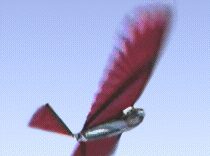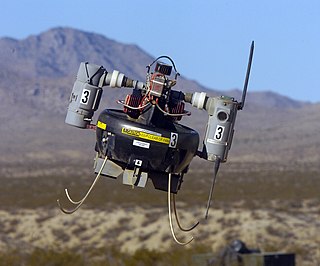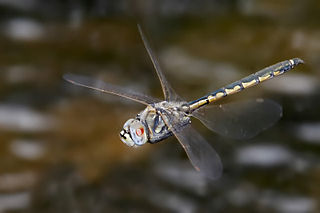
Aeronautics is the science or art involved with the study, design, and manufacturing of air flight-capable machines, and the techniques of operating aircraft and rockets within the atmosphere. The Royal Aeronautical Society identifies the aspects of "aeronautical Art, Science and Engineering" and "The profession of Aeronautics ."

Hummingbirds are birds native to the Americas and comprise the biological family Trochilidae. With approximately 366 species and 113 genera, they occur from Alaska to Tierra del Fuego, but most species are found in Central and South America. As of 2024, 21 hummingbird species are listed as endangered or critically endangered, with numerous species declining in population.

The rufous hummingbird is a small hummingbird, about 8 cm (3.1 in) long with a long, straight and slender bill. These birds are known for their extraordinary flight skills, flying 2,000 mi (3,200 km) during their migratory transits. It is one of nine species in the genus Selasphorus.

The ruby-throated hummingbird is a species of hummingbird that generally spends the winter in Central America, Mexico, and Florida, and migrates to Canada and other parts of Eastern North America for the summer to breed. It is the most common hummingbird in eastern North America, having population estimates of about 35 million in 2021.

An ornithopter is an aircraft that flies by flapping its wings. Designers sought to imitate the flapping-wing flight of birds, bats, and insects. Though machines may differ in form, they are usually built on the same scale as flying animals. Larger, crewed ornithopters have also been built and some have been successful. Crewed ornithopters are generally powered either by engines or by the pilot.

A micro air vehicle (MAV), or micro aerial vehicle, is a class of man-portable miniature UAVs whose size enables them to be used in low-altitude, close-in support operations. Modern MAVs can be as small as 5 centimeters - compare Nano Air Vehicle. Development is driven by commercial, research, government, and military organizations; with insect-sized aircraft reportedly expected in the future. The small craft allow remote observation of hazardous environments or of areas inaccessible to ground vehicles. Hobbyists have designed MAVs for applications such as aerial robotics contests and aerial photography. MAVs can offer autonomous modes of flight.

The calliope hummingbird is the smallest bird native to the United States and Canada. It has a western breeding range mainly from California to British Columbia, and migrates to the Southwestern United States, Mexico, and Central America for its wintering grounds. The calliope hummingbird is the smallest known long-distance bird migrant, completing migrations twice per year of some 9,000 km (5,600 mi).

The southern giant hummingbird is one of two species in the genus Patagona and the second largest hummingbird species, after its close relative the northern giant hummingbird.

Bionics or biologically inspired engineering is the application of biological methods and systems found in nature to the study and design engineering systems and modern technology.

Bird flight is the primary mode of locomotion used by most bird species in which birds take off and fly. Flight assists birds with feeding, breeding, avoiding predators, and migrating.

A V formation is a symmetric V- or chevron-shaped flight formation. In nature, it occurs among geese, swans, ducks, and other migratory birds, improving their energy efficiency, while in human aviation, it is used mostly in military aviation, air shows, and occasionally commercial aviation.

Insects are the only group of invertebrates that have evolved wings and flight. Insects first flew in the Carboniferous, some 300 to 350 million years ago, making them the first animals to evolve flight. Wings may have evolved from appendages on the sides of existing limbs, which already had nerves, joints, and muscles used for other purposes. These may initially have been used for sailing on water, or to slow the rate of descent when gliding.

Torkel Weis-Fogh was a Danish zoologist and Professor at the University of Cambridge and the University of Copenhagen. He is best known for his contributions to the understanding of insect flight, especially the clap and fling mechanism used by very small insects. James Lighthill named this "the Weis-Fogh mechanism of lift generation".

Around 350 BCE, Aristotle and other philosophers of the time attempted to explain the aerodynamics of avian flight. Even after the discovery of the ancestral bird Archaeopteryx which lived over 150 million years ago, debates still persist regarding the evolution of flight. There are three leading hypotheses pertaining to avian flight: Pouncing Proavis model, Cursorial model, and Arboreal model.

Flapping counter-torque is a ubiquitous passive rotational damping effect in flapping flight that arises from world frame differences in the speed of flapping wings during turns. During a turns, flapping that is symmetrical in the body frame of the animal is not symmetrical in the lab frame.
Charles Porter Ellington FRS was a British zoologist, emeritus Fellow Downing College, Cambridge, and professor emeritus at University of Cambridge.
Wing-assisted incline running is a running behavior observed in living birds as well as a model proposed to explain the evolution of avian flight. WAIR allows birds to run up steep or vertical inclines by flapping their wings, scaling greater inclines than possible through running alone. The WAIR origin-of-flight hypothesis proposes that the nascent wings of theropod dinosaurs were used to propel the animal up slopes, such as cliffs or trees, in a similar manner to that employed by modern birds, and that powered flight eventually evolved from this usage. During its proposal, it was suggested that WAIR might have plausibly been used by feathered theropods like Caudipteryx to develop aerial flight.
Adrian Leland Rees Thomas is a professor of biomechanics at the University of Oxford and Director of Studies in Biological Sciences at Lady Margaret Hall, Oxford running the Animal Flight Research Group. He is co-founder and Chief Scientific Officer at Animal Dynamics and is also chairman of the flight section of the Bionis International Biomimetics Network.
Andrew Biewener is the Charles P. Lyman Professor of Biology in the Department of Organismic and Evolutionary Biology at Harvard University and Faculty Director of the Concord Field Station. He is also a Fellow of the American Association for the Advancement of Science.

Hovering is the ability exhibited by some winged animals to remain relatively stationary in midair. Usually this involves rapid downward thrusts of the wings to generate upward lift. Sometimes hovering is maintained by flapping or soaring into a headwind; this form of hovering is called "wind hovering", "windhovering", or "kiting".















